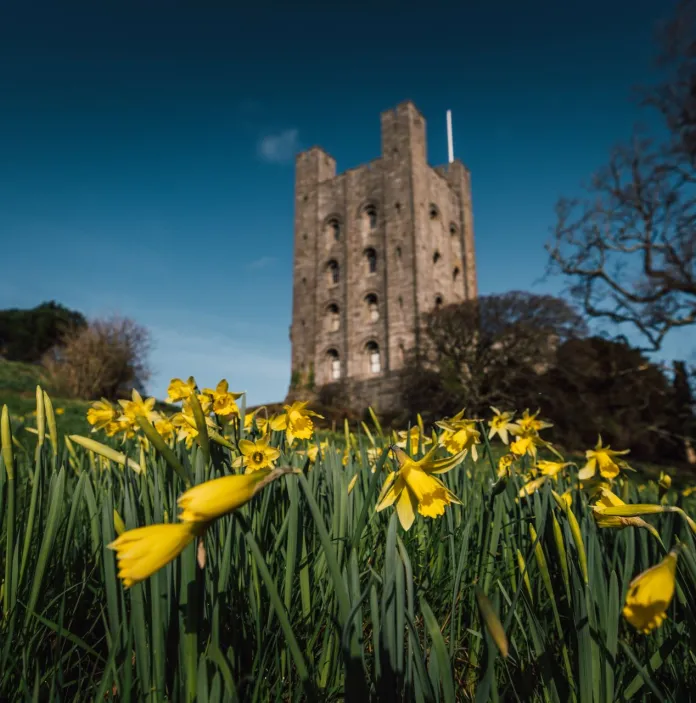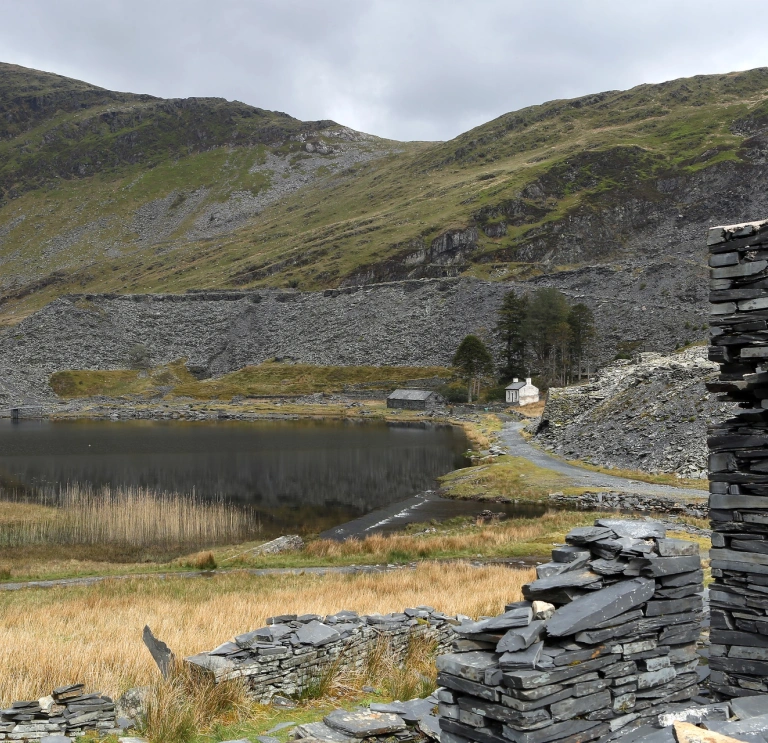In July 2021 the Slate Landscape of Northwest Wales became the fourth UNESCO World Heritage Site in Wales, along with the Castles and Town Walls of King Edward I, Pontcysyllte Aqueduct and Canal and Blaenavon Industrial Landscape.
The story of Welsh Slate is significant. There is a special place in the pages of the history books of Wales for the post-industrial landscape and its communities, which have left a mark on the area, the country and the world.
Slate revolutionised the quiet, mountainous areas of North Wales. The creation of the quarries, and the rubble heaps around them, formed a new visual landscape. Vibrant cultural communities were created in these six areas, and this cultural landscape is as important today as ever.
Dyffryn Ogwen
At one time, Penrhyn Quarry was the largest quarry in the world and slate production continues here to this day. The site of the original quarry is enormous, and one of the best ways to appreciate the scale is to glide over it on the world's fastest zip wire. The Zip World quarry tour is also an informative introduction to the history of the quarry, as well as an opportunity to enjoy views over the valley and the Menai Strait.
Penrhyn Castle was built to underline the social status of the family of industrialists who owned the quarry and is now owned by the National Trust. Despite the spectacular architecture and luxurious rooms, for many, the building represents a history of oppression and hardship. There is also a dark history attached with links to the transatlantic slave trade in Jamaica's sugar plantations.

The town of Bethesda developed into a community for the quarrymen and their families over the period, and the close-knit community atmosphere is still as strong as ever thanks to initiatives such as Partneriaeth Ogwen. The partnership works to benefit the economy, environment and communities of Dyffryn Ogwen, and includes running the local shop and community library in the town. Community and arts hub Neuadd Ogwen is host to a special programme of live events with music, theatre, comedy and literary sessions taking place regularly.
If you want to venture towards Llyn Ogwen to enjoy the circular walk with views of Tryfan and the Glyderau, it is better to park in Bethesda and catch the T10 bus up to Cwm Idwal or the Bws Ogwen service - a 9-seater electric bus that runs from Bethesda to Llyn Ogwen. This is another Partneriaeth Ogwen initiative, with the aim of reducing Eryri (Snowdonia) National Park's carbon emissions and getting more visitors to support local businesses in Bethesda when visiting the area.
To learn more about the area’s industrial history follow The Slate Trail along the Lôn Las Ogwen route. Interpretation panels and QR codes have been installed along the route and the information is also available in pdf format. A recent development is the new centre in Nant Ffrancon with interactive interpretation facilities, information and refreshments.

Dinorwig Quarry
The Dinorwig Quarry area is particularly beautiful. Yr Wyddfa (Snowdon) is a stone’s throw away, along with the lakes of Padarn and Peris, and Castell Dolbadarn (Dolbadarn Castle) keeping a watchful eye over the valley below since the 13th century.
Amgueddfa Lechi Cymru (The National Slate Museum) in Llanberis, at the foot of Dinorwig Quarry, is at the heart of the area. For half a century it has been reciting and recording the stories of the Welsh slate industry in the Victorian workshops of the old quarry. Here, you can travel back in history to see a way of life that is now an integral part of Wales' identity. Make sure you catch one of the demos with the talented craftsmen who show off their slate splitting skills.

From water sports to walking to wildlife, nearby Llyn Padarn Country Park has it all. Ropeworks adventure centre offers fun experiences for individuals, families and large groups who are brave enough to venture on the high ropes course, and Boulder Adventures offers water experiences such as kayaking, gorge scrambling and canoeing.
Over the Easter and summer holidays the old Quarry Hospital above Llyn Padarn opens as a museum, offering the opportunity to see medical equipment, an operating room, an original X-ray machine and various eerie gadgets from the 19th century.
In the 1840s a railway was built along the shores of Llyn Padarn - the first in this quarry landscape to use steam engines. Today Llanberis Lake Railway celebrates half a century of visitor train journeys, and organises a number of seasonal events for the family including Halloween tours.
Another train to catch in the area is, of course, the Snowdon Mountain Railway. The railway and summit café Hafod Eryri is open from April until the end of October.
Llanberis is extremely popular and busy during the holidays, but if you’re lucky enough to grab a table at the Pantri on the village’s high street you’ll be treated to a good selection of local food. A stone's throw from Llanberis is Caban in Brynrefail - a social co-operative with an art gallery and cafe selling the best of local produce including fruit and veg and honey from the community garden. Another great place to buy local produce is the Menter Fachwen shop on the high street in Llanberis, which sells a good selection of cakes and homemade jam, Coffi Eryri, has a great supply of local beers including Bragdy Lleu, a brewery in Dyffryn Nantlle that names each beer after the characters of the Mabinogi, and the locally distilled Blue Slate Gin.
Dyffryn Nantlle
Dyffryn Nantlle is an area with a long and varied archaeological history. Topography and geology have meant that quarries have been confined within very limited areas. But a great way to explore the area is to follow the Bro Nantlle Slate Walks. There are five walks in total, including through the village of Rhosgadfan, the childhood home of Kate Roberts - one of Wales’ most important Welsh writers of the 20th century, and commonly known as Brenhines ein Llên (Queen of Our Literature). Her work reflects on the struggles of quarrying communities, often through the eyes of a child.

Pant Du vineyard and orchard is located on the slopes of Dyffryn Nantlle - the first vineyard in Wales to run off solar energy. If you're visiting between June and September make sure you join one of owner Richard Huws' entertaining and informative guided tours, to hear the stories and challenges of running a vineyard on the slopes of the valley - and book a table in the restaurant afterwards to enjoy a local meal and a taste of the wine and cider produced at the site.
Yr Orsaf in Penygroes is a unique community initiative which aims to develop the creative and digital skills of the residents of the area, as well as offering a place to meet for a drink and a meal. There are gigs, poetry and film evenings too. The old building, once a thriving high street shop, was saved by a group of volunteers in 2016, and a committee called Siop Griffiths Cyf was established to ensure that the historic building remains in the hands of the community.
Poblado, one of Wales' main coffee artisans are based in Dyffryn Nantlle and roast in the old quarrymen's barracks in Nantlle. Poblado's social vision is as strong as their coffee, and the coffee afternoons and live music, Bandiau'r Rhosty, are extremely popular.
Gorseddau and Bwlch y Ddwy Elor
The Gorseddau and Bwlch y Ddwy Elor quarries were developed in Cwmystradllyn and Cwm Pennant between 1850 and 1870 - the 'Golden Age' of the slate industry in Gwynedd. There was a significant investment in both quarries, but due to the poor quality of the rock, the investment never materialised into slate production. Local people however take pride in both quarries, and it is this, along with the care of Eryri (Snowdonia) National Park, that has assured the remarkable survival of archaeological evidence here.
Ynysypandy Slate Mill is one of the most iconic buildings in the area. It is an imposing building, inspired by foundry design, reflecting the background of its investors. It still sits grandly in the midst of mountains and is a popular spot for walks incorporating tea stops at Tyddyn Mawr Tea Room.

Ffestiniog and Porthmadog
Blaenau Ffestiniog - 'the capital city of slate' and 'the town that roofed the world' - is now one of the best outdoor activity hubs in Wales.
The external remains of the quarries are very impressive, but so much of Blaenau's history is hidden underground. Inclines, networks of railways and machines of all kinds have survived and it is possible to catch a glimpse of them at Zip World Llechwedd on the Deep Mine Tour, while jumping on Bounce Below trampolines, or playing underground golf.
Antur Stiniog is a world-class mountain biking centre with 14 downhill mountain bike trails, graded from green to black, for riders of all abilities. And for those who prefer to dart above the mounds rather than down them, you can also discover Llechwedd’s quarries from 1,400 feet above.


For a slightly more relaxed outdoor adventure the Bro Ffestiniog Slate Walks are a series of nine trips including Cwmorthin and Llan Ffestiniog.
From Porthmadog harbour, ships transported Blaenau Ffestiniog slate across the world. The ships were built in Porthmadog, and the locals were crewmen. The town's Maritime Museum tells the story of the time, and the harbour is popular today as a mooring for yachts and leisure boats.
Connecting ‘Stiniog’ and ‘Port’ is the Ffestiniog & Welsh Highland Railway. After travelling over the Cob and the Glaslyn estuary the 13.5 mile journey winds through mountains and forests, past lakes and waterfalls.
Read More: A stroll through Stiniog
Abergynolwyn and Tywyn
This area in south Gwynedd is far from Bethesda, Llanberis, Nantlle and Blaenau Ffestiniog, which shows the importance of the slate industry throughout the region. Farming, forestry, and pretty seaside villages and towns are the main features of the area today. But slate was also important at one time, and the industry has left its mark, mainly via the railway tracks.
Rheilffordd Talyllyn Railway was the first railway in the world to be successfully saved and operated by volunteers as a visitor attraction in 1951. The narrow gauge line was built to serve Bryneglwys Quarry above Abergynolwyn. The two original engines, 'Talyllyn' and 'Dolgoch', are still in use, travelling through the scenic Fathew Valley. They also organise special seasonal events such as train rides with Santa and the Slate Trail - a unique experience where you can learn about the rich history of the railway, Bryneglwys Quarry, and its part in the Slate Landscape of Northwest Wales UNESCO World Heritage Site. Head to the Natural Resources Wales website for information about visiting Bryneglwys Quarry.
Read More: A local's guide to exploring Tywyn
Snowdonia Slate Trail
Inspired to explore and discover the Slate Landscape of Northwest Wales? The 83-mile Snowdonia Slate Trail is a great place to start. The full journey can be walked in a week, or sections can be broken into smaller journeys. Remember to collect stamps at specific points along the way to put in the Snowdonia Slate Trail Passport, to be exchanged for a Slate Trail medal after finishing the journey.
Visitor safety
The Slate Landscape of Northwest Wales is undoubtedly fascinating but can be remote, dangerous and challenging. A significant proportion of the landscape is within private ownership, and no public access is permitted.
Before you set off to explore, check if you’re allowed to access the site and have the right equipment, knowledge and skills. Visit the Adventure Smart UK website for advice on how to enjoy your visit safely.
For more information about the history and heritage of the Northwest Slate Landscape visit the Wales Slate website.
For more inspiration about the region around the Wales Slate area head over to the Visit Eryri (Snowdonia) website.






